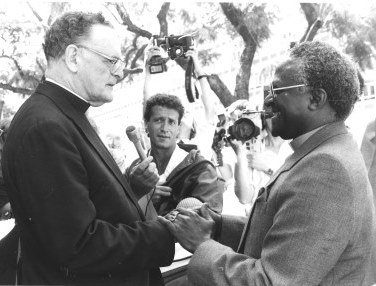
| Denis Hurley was a courageous opponent of South Africa's apartheid regime for 50 years, dubbed by opponents ‘the scourge of Apartheid’ and ‘an ecclesiastical Che Guevara’; the writer Alan Paton (noting Hurley’s father’s profession as a lighthouse keeper) called him the ‘Guardian of the Light’. As well as being a significant figure in the Struggle in South Africa, he also had great international influence within the Catholic Church. He was an instigator and then a champion of the ecclesiastical and liturgical reforms of the Second Vatican Council which he attended in the 1960s and regarded as the highlight of his life. |
Born in Cape Town on 9 November 1915 of Irish parents, he joined the Catholic male religious order, the Oblates of Mary Immaculate (OMI) and was ordained a priest at the age of 24 after studying in Ireland and Rome. In 1947, at the age of only 31, he became the youngest Catholic bishop in the world and was elevated to be Archbishop of Durban in 1951 (and was also the youngest Catholic archbishop at that time).
His career as an outspoken opponent of apartheid began in 1951 when, as chair of the Southern African Catholic Bishops' Conference, he drafted the first of the ground-breaking pastoral letters in which the bishops denounced apartheid as ‘blasphemy’ and ‘intrinsically evil’.
Eventually along with four other South African religious leaders (including the Anglican Archbishop, Desmond Tutu), he was regarded as one of the South African state's ‘most wanted’ political opponents. In 1984 he was charged with making false statements about the Koevoet counter-insurgency unit in Namibia. The prosecutor dropped the charges when it became clear that Hurley would be able to prove the truth of his statements.
He retired as archbishop in 1992, becoming Chancellor of the University of Natal from 1993 to 1998. He continued to work as parish priest of Emmanuel Cathedral well into his eighties and died on 14 February 2004 aged 88. His funeral, held at Kings Park stadium, was a major city event attended by national and international dignitaries and he is buried, following Catholic tradition, in the Cathedral (where he had worked as curate, bishop and administrator for 57 the previous 62 years), just to the right of the main altar.